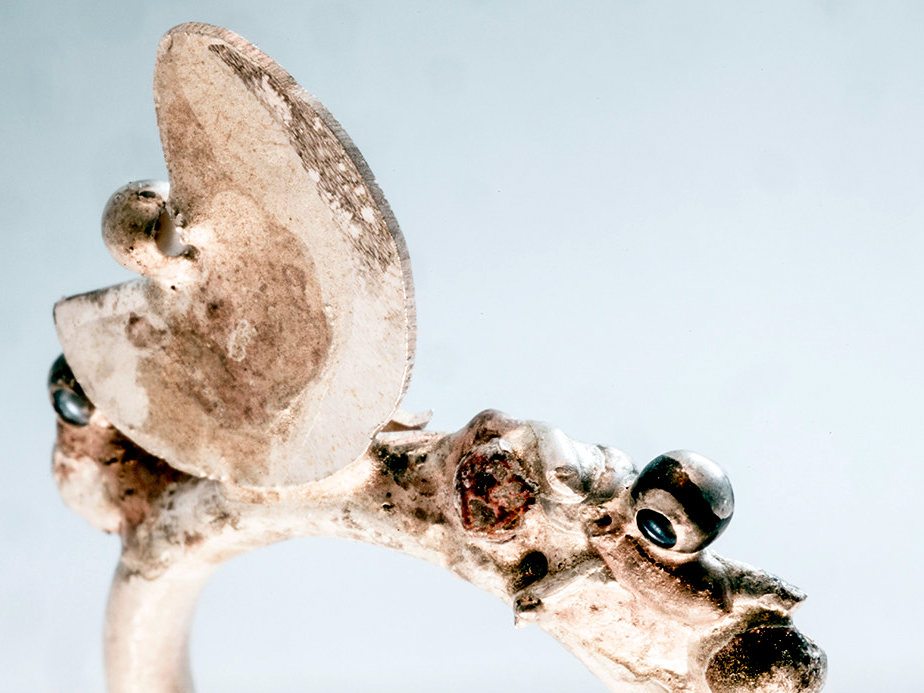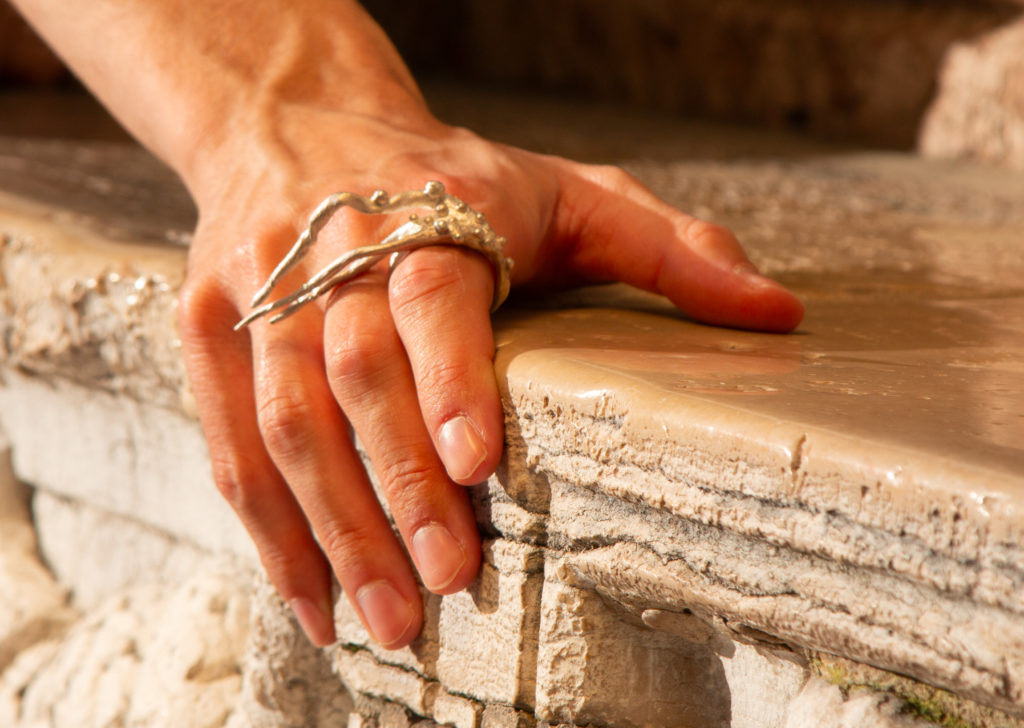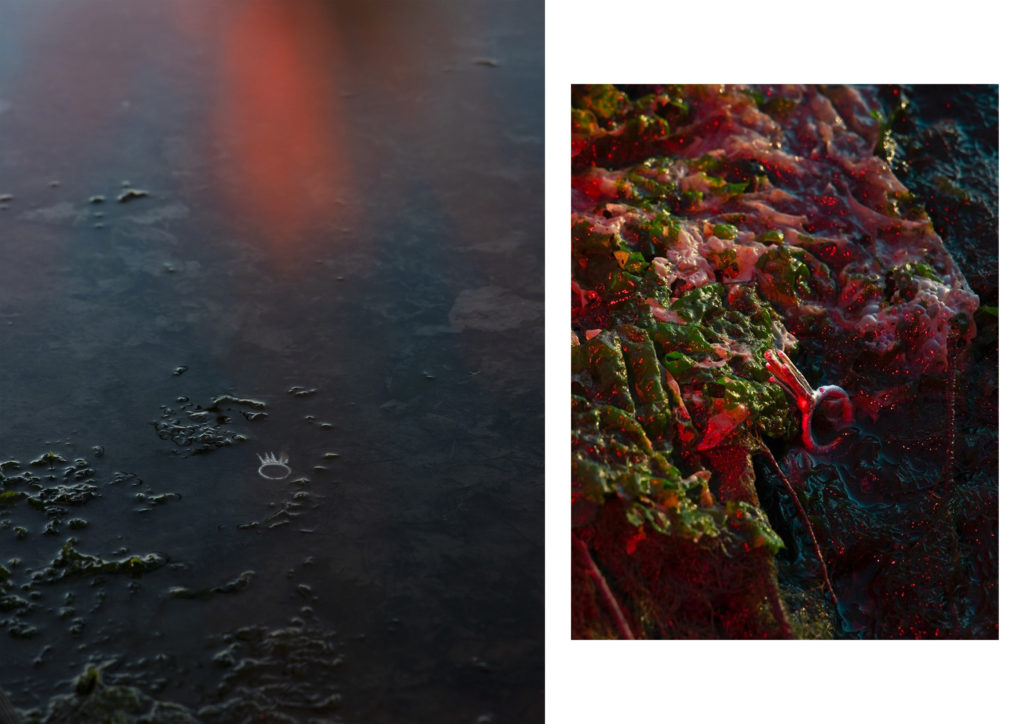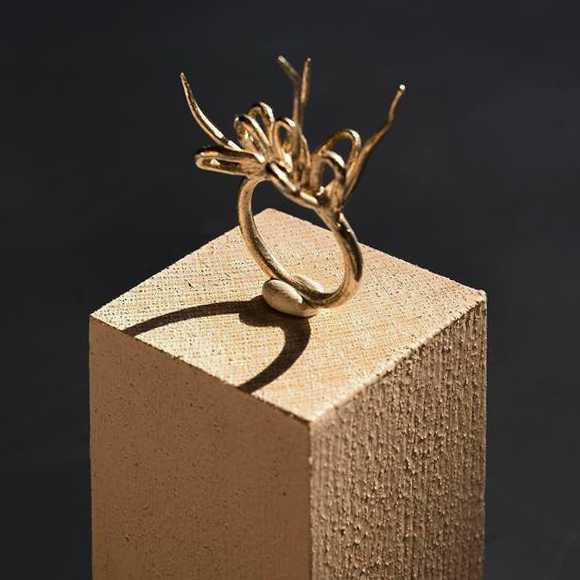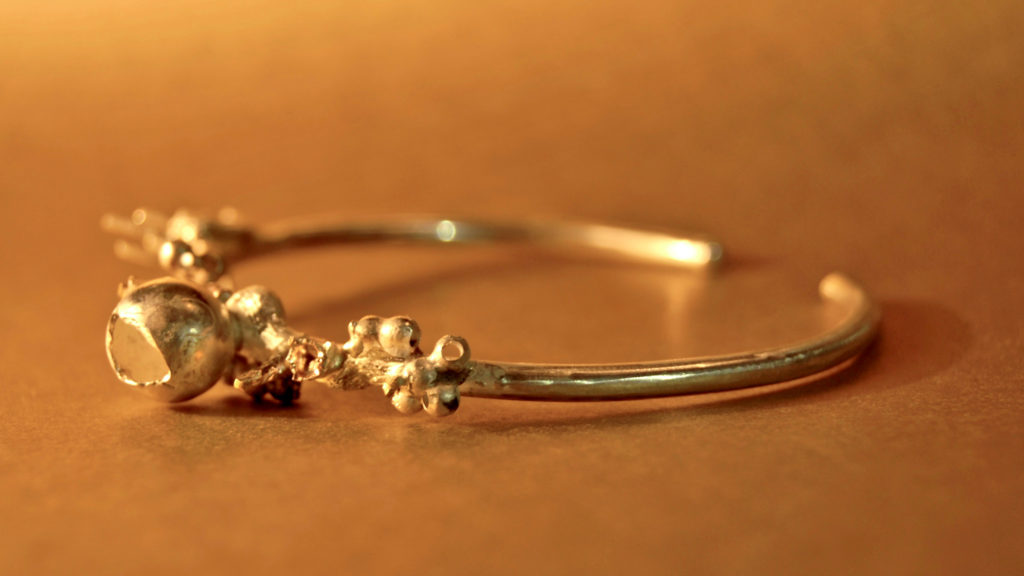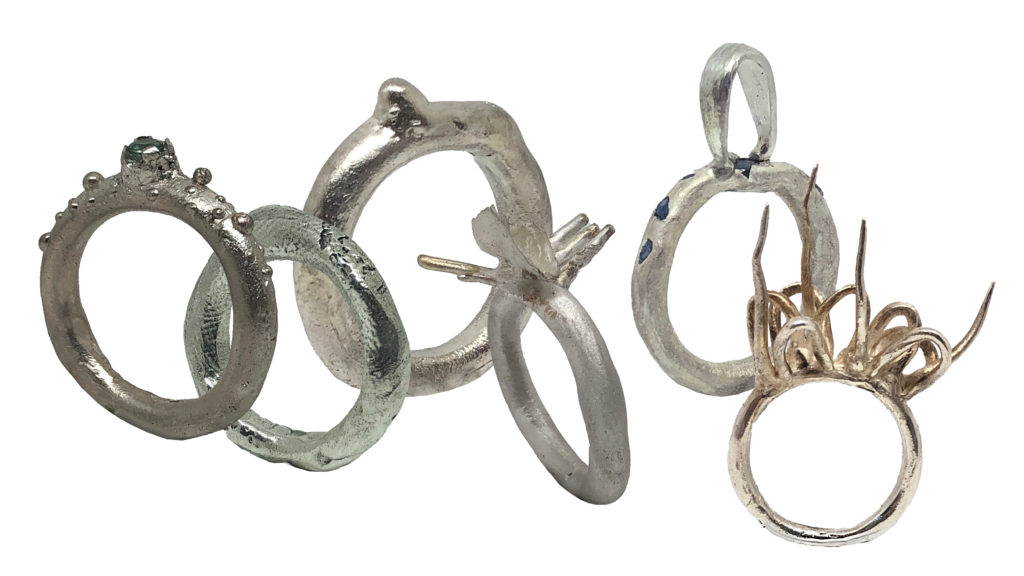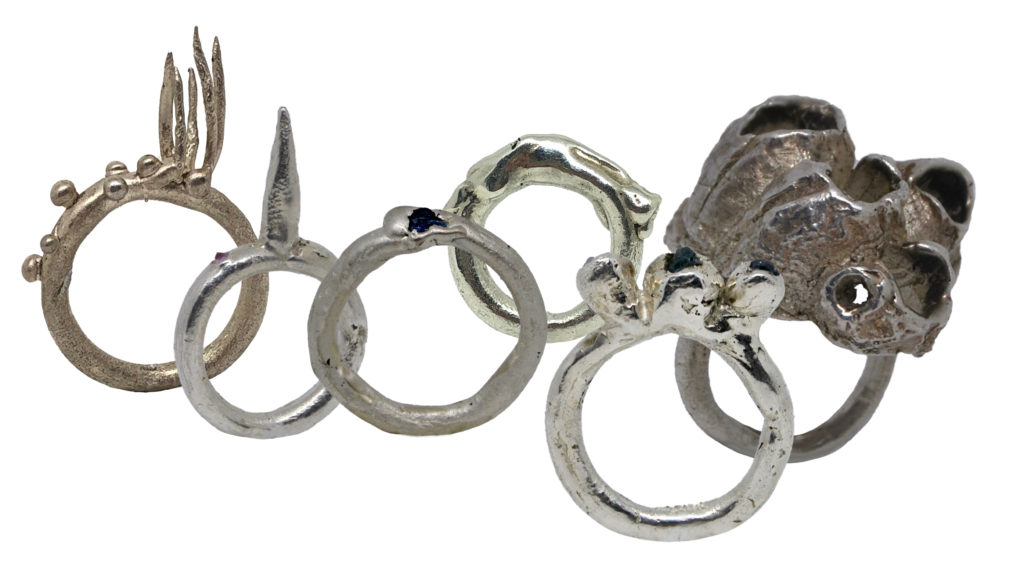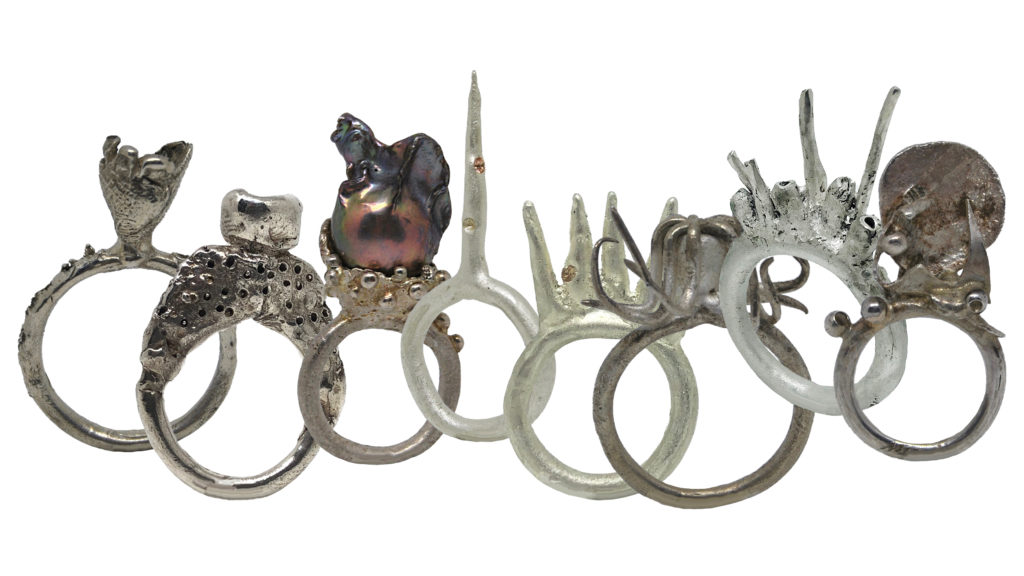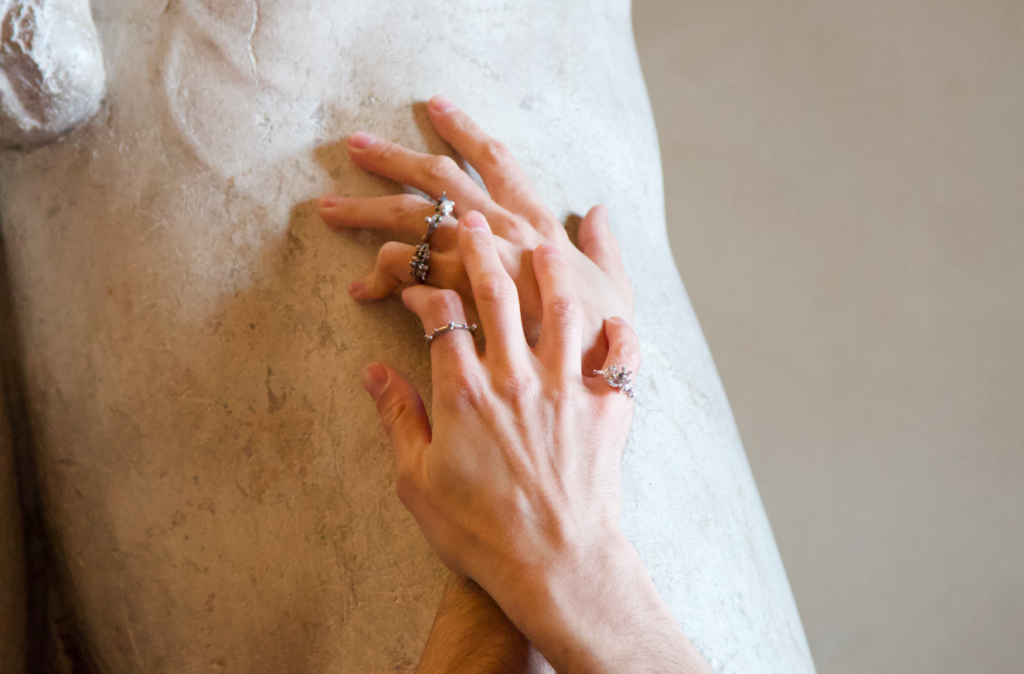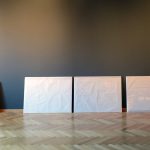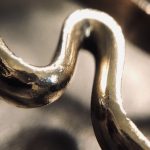english below
Appassionata, determinata, intraprendente…
Giulia Vecchiato, in arte SURI
scopre la sua vocazione per il gioiello contemporaneo
a Venezia, dov’è nata, vive e crea.
La città è una parte importante del suo lavoro, dice.
“Il ritmo è lento, la luce è acquosa e statica, la memoria intrappolata in ogni crepa.
Tradizione e trasgressione, malinconia e reiterazione.
SURI vuole essere un inno alla mia città, al suo profumo umido, ai suoi drammi, alla sua forza e alle sue contraddizioni.
Ogni pezzo cerca di rivelarne la forza, preziosità, organicità e fragilità.
Ogni pezzo è elegante e grezzo, fragile e monumentale, visivo e letterario, antico e contemporaneo.
Voglio che i miei gioielli siano come incrostazioni poetiche che alludono a un immaginario dimenticato, come qualcosa che rimane sommerso nel fondo del mare e ritorna inaspettatamente a riva.”
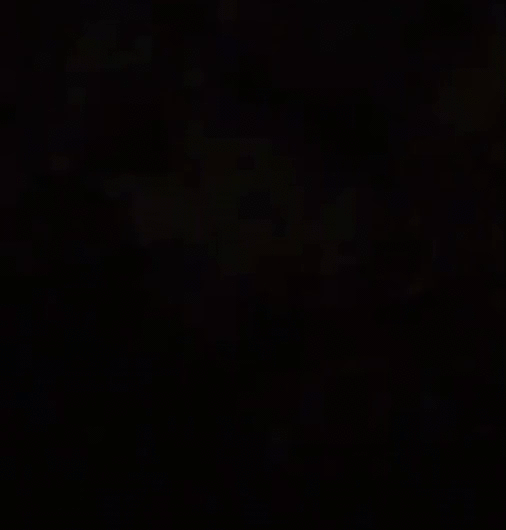
video : Joaquín Gomez
Æ – Quando, come e perché nasce SURI? Il suo significato?
GV – SURI nasce nel 2018. Dopo la mia laurea magistrale all’Accademia di Belle Arti di Venezia, nel 2016, ho deciso di iscrivermi ad un corso di oreficeria a banco, a Vicenza, per apprendere le tecniche tradizionali ed iniziare a muovermi autonomamente nel mondo del gioiello. Durante questo anno di scuola orafa ho avuto la conferma che il gioiello fosse la dimensione in cui volevo stare. Ho deciso quindi di procurarmi il necessario per allestire un piccolo laboratorio in casa, che ad oggi è ancora il mio studio. SURI nasce dalla voglia di dare un’identità al mio lavoro nel gioiello contemporaneo.
SURI nasce dalla voglia di dare un’identità al mio lavoro nel gioiello contemporaneo.
SURI è il soprannome con cui mi conoscono tutti, viene da uno stupido errore di pronuncia: avevo circa tredici anni, ballavo e cantavo con mia sorella una canzone di Madonna dicendo “… time goes by so suri, so suri, so suri…” e da qual momento lei iniziò a chiamarmi così. Non so ancora bene come sia accaduto, ma il risultato è che ormai tutti mi chiamano così. Nel 2018 quindi ho sentito la necessità di dare un nome a quello che stavo facendo, e così decisi che SURI sarebbe stato il nome perfetto.

Æ – Come ti sei avvicinata al gioiello contemporaneo?
GV – Quando frequentavo l’Accademia lavoravo soprattutto con la scultura, facevo dei grandi lavori in gesso e metallo, avvicinandomi per la prima volta alla saldatura. Le dimensioni delle sculture aumentavano sempre di più, finchè il mio professore mi pregò di iniziare a pensare in piccolo, perchè non c’era più spazio per altri lavori grandi. In quel momento una piccola luce si è accesa nella mia testa: il gioiello può essere scultura!
In quel momento una piccola luce si è accesa nella mia testa:
il gioiello può essere scultura!
Quest’idea continuava ad evolversi in me, rimanendo viva e sempre più convincente. Quando ho realmente iniziato ad approcciarmi al gioiello sono partita dalla tecniche tradizionali, apprendendone le regole fondamentali per avere una solida base su cui muovermi. Quando ho cominciato a lavorare autonomamente nel mio laboratorio, col gioiello è stato un approccio spontaneo, da subito era micro scultura. Facendo continua ricerca sono venuta a conoscenza del piccolo mondo del gioiello contemporaneo, una nicchia sconosciuta ai più…
Dal 2017, parallelamente al mio lavoro, ho iniziato a lavorare con Ilaria Ruggiero, assistendola durante le mostre realizzate con il suo progetto di curatela del gioiello contemporaneo, Adornment. Questo mi ha portata ad inserirmi e conoscere sempre di più la realtà di questo mondo che da subito mi è sembrato quasi identico a quello dell’arte contemporanea. Infatti i meccanismi e le modalità sono gli stessi: progetti, mostre, curatori, collezionisti, gallerie…
A prescindere da queste dinamiche credo che in questo momento il gioiello contemporaneo sia il luogo in cui voglio agire, senza precludermi di ritornare alla scultura o ad altre pratiche quando ne sentirò l’attrazione.
- ph. Fabio Ranzolin
Æ – Qual’è stato il primo pezzo mai realizzato?
GV – Il primo pezzo mai realizzato è un anello. Gli anelli sono l’anima di SURI, oggetti magici da portare sempre con sé. Le mani per me sono uno strumento molto prezioso, danno forza, forma, movimento, supporto, protezione.
Le mani per me sono uno strumento molto prezioso,
danno forza, forma, movimento, supporto, protezione.
Mi viene in mente Elena Bernabè che le definisce strumento di connessione con il nostro essere più profondo.
Il mio primo anello risale al 2017, un meraviglioso chevalier con una fedina a filo tondo in ottone con una galvanica nera, su cui poggia una perla lilla. A distanza di anni lo guardo ancora con grande amore, un anello semplice ma super contemporaneo nelle proporzioni e nei colori.
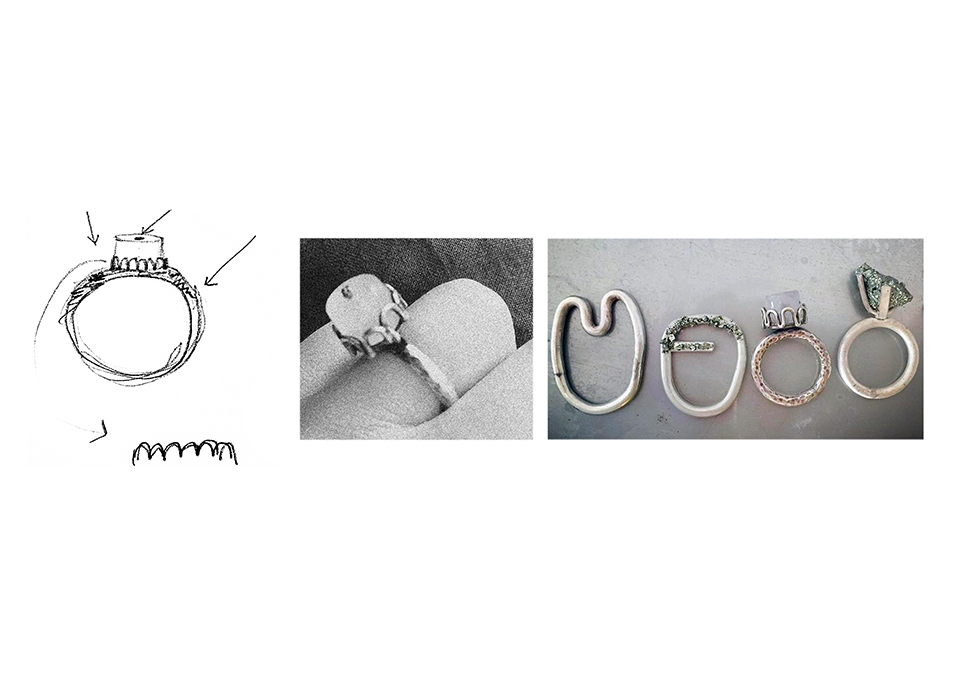
Æ – Cosa stimola il tuo fare creativo?
GV – Sono interessata alla materia, darle forma è il mio modo di esprimermi.
Venezia, la mia città, è una parte importante del mio lavoro in termini di ispirazione e punto di vista da cui guardarsi attorno. Il ritmo è lento, la luce è acquosa e statica, la memoria è intrappolata in ogni crepa, tradizione e trasgressione, malinconia e reiterazione sono ovunque.
SURI è anche un inno alla mia città, al suo profumo umido, ai suoi drammi, alla sua forza e alle sue contraddizioni.
Ogni pezzo cerca di rivelarne la forza, preziosità, organicità e fragilità.
- ph. Federico Vespignani
Æ – Qual’è il punto di partenza di un pezzo?
Un’idea, un’immagine, un disegno, uno stampo…?
O c’è materia, improvvisazione, istinto?
GV – Non mi sono mai trovata a mio agio con la progettazione vera e propria.
La scuola orafa mi ha insegnato molte cose, tra cui il disegno dei progetti, poi come succede spesso, si finisce per sovvertire le regole apprese in funzione di una ricerca funzionale al proprio modo di lavorare. Premesso che la mia filosofia etica non prevede l’idea di una produzione seriale e continua di oggetti, ogni anno realizzo una piccola produzione di pezzi unici che nascono sotto forma di mini collezioni. Nella maggior parte dei casi le mie collezioni nascono con un’idea precisa dell’estetica globale che voglio far emergere, quindi scrivo, disegno e prendo nota (sempre su carta!) per fissare alcuni dettagli, tecnici e non, che serviranno da guida nella realizzazione dei pezzi. La riflessione sul processo fatta in precedenza trova anche qui terreno fertile: mi eccita il fatto di non avere un’immagine precisa di come sarà il pezzo finito, è la materia stessa a parlare e dirigere le mie mani mentre la lavoro.
… mi eccita il fatto di non avere un’immagine precisa di come sarà il pezzo finito,
è la materia stessa a parlare e dirigere le mie mani mentre la lavoro.
In conclusione direi quindi che c’è tutto: un’idea dell’atmosfera cui voglio arrivare, scrittura per ricordarmi che sapore voglio sentire, ma c’è anche molto istinto.
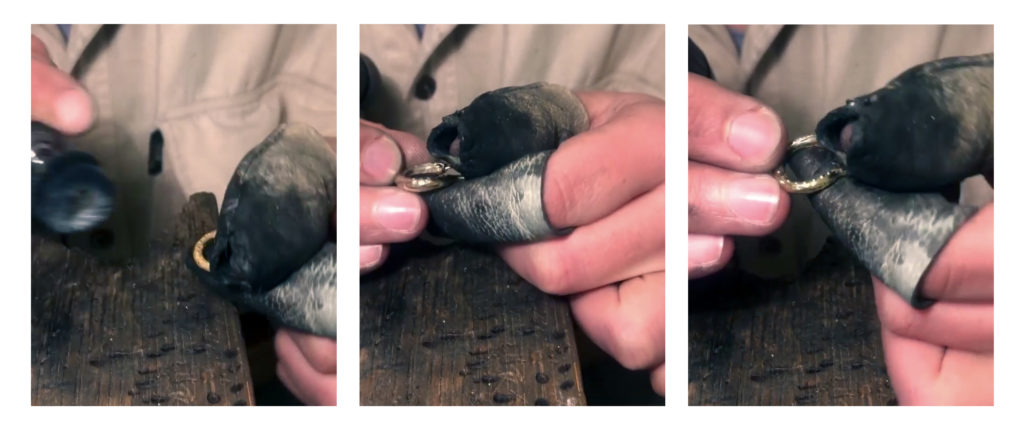
Giulia Vecchiato in laboratorio
Æ – Materiali d’elezione?
GV – Da subito mi sono innamorata dell’argento. È un metallo meraviglioso che continua a svelarmi nuove possibilità. Dell’argento amo molto il colore che racchiude in realtà una moltitudine di tonalità in base alla lavorazione. Per me è un metallo che parla, di acqua, di luna, di luce…
Amo molto lavorare con l’oro, specialmente rosa o giallo, con il quale cerco sempre di demolire l’idea che un gioiello in oro possa apparire “vecchio”. Sta tutto nel modo in cui viene trattata la materia. In generale comunque sono profondamente legata al metallo; i processi di trasformazione di questo materiale sono una parte fondamentale del mio lavoro. Mi trovo spesso a riflettere su quanto il processo stesso sia per me il momento più denso di energia, il mio corpo si nutre di queste vibrazioni e ne trae un reale godimento, più di quanto non accada quando arrivo a vedere la conclusione della lavorazione di un gioiello.
Mi trovo spesso a riflettere su quanto il processo stesso sia per me il momento più denso di energia,
il mio corpo si nutre di queste vibrazioni e ne trae un reale godimento,
più di quanto non accada quando arrivo a vedere la conclusione della lavorazione di un gioiello.
SURI è sempre più focalizzato su un’idea etica di prodotto e materiale, infatti l’utilizzo di oro, argento e pietre è volto a garantire continuità e solidità indiscusse nel tempo. Il fatto di non scegliere materiali come plastica, gomma o carta, nonostante riciclati, è finalizzato ad una maggiore coerenza in termini di rifiuti futuri.
- ph. Marco Valmarana
Æ – Quanto spazio lasci all’imperfezione?
GV – Non credo al concetto di imperfezione. Certamente i miei gioielli sono organici, ruvidi, invadenti, appuntiti.. non sono composti, puliti e misurati. Osservando con una lente di ingrandimento la superficie dei miei gioielli, si nota subito la presenza di una moltitudine di micro elementi: segni, palline, agglomerati, buchi, texture più ruvide, zone specchianti lucidissime… ecco per me ognuno di questi elementi è parte fondamentale di ogni pezzo, non c’è nulla di messo lì per errore. Voglio far parlare la materia dandole forma ma anche lasciandola emergere quando sento che è lei a “spingere”.
Voglio far parlare la materia dandole forma ma anche lasciandola emergere…
- ph. Giulia Vecchiato
Æ – Quando capisci che è il momento di non aggiungere più? Di “concludere” un pezzo?
GV – Questa è una certezza di un attimo ma anche un processo che può durare giorni, mesi, a volte anni!
Mi è capitato di riprendere in mano dei pezzi che avevo accantonato da tempo e sentire che il mio lavoro con loro non era ancora finito.
Mi è capitato di riprendere in mano dei pezzi che avevo accantonato da tempo
e sentire che il mio lavoro con loro non era ancora finito.
Non c’è sempre una regola o un momento preciso, nella maggior parte dei casi questa consapevolezza si accende nella fase di osservazione dei pezzi che avviene durante la fase di finitura – quando inizio a lucidare, sbiancare o satinare il metallo.
La materia comunque parla sempre.
- ph. Giulia Vecchiato
- ph. Giulia Vecchiato
- ph. Giulia Vecchiato
Æ – Fondere metalli : “distruggi” mai un pezzo creato?
GV – La fusione non è mai distruzione, è sempre riciclo! Per ora mi è capitato poche volte di fondere dei pezzi che non mi convincevano abbastanza. In ogni caso lo faccio con una buona dose di leggerezza, è importante per me non sentirmi mai ferma o troppo aggrappata ad un gioiello o uno “stile”.
D’altronde chi realizza pezzi unici non può permettersi di affezionarcisi troppo, bisogna lasciarli andare, ricordandosi sempre di fotografarli prima di salutarli!
D’altronde chi realizza pezzi unici non può permettersi di affezionarcisi troppo,
bisogna lasciarli andare, ricordandosi sempre di fotografarli prima di salutarli!
- ph. Fabio Ranzolin
***
Passionate, determined, resourceful …
Giulia Vecchiato, in art SURI,
discovered her vocation for contemporary jewellery
in Venice, where she was born, lives and creates.
The city is an important part of her work, she says.
“The pace is slow, the light is aqueous and static, memory is trapped in every crack.
Tradition and transgression, melancholy and recurrence.
SURI wants to be a hymn to my city, to its humid aroma,
its dramas, its strength and its contradictions.
Every piece tries to reveal its strength, preciousness, organic unity and fragility.
Each piece is elegant and rough, fragile and monumental, visual and literary,
ancient and contemporary.
I want my jewels to be like poetic encrustations that allude to a forgotten fantasy,
like something that remains submerged at the bottom of the sea and
unexpectedly returns to shore.

video : Joaquín Gomez
Æ – When, how and why was SURI born? What does it mean?
GV – SURI was born in 2018. After my master’s degree at the Academy of Fine Arts in Venice, in 2016, I decided to enrol in a bench goldsmithing course in Vicenza to learn traditional techniques and start moving independently in the world of jewellery. During this year of goldsmith school I had the confirmation that the jewel was the dimension for me. I therefore decided to procure what was needed to set up a small workshop at home, which is still my studio today. SURI was born from the aim of giving an identity to my work in contemporary jewellery.
SURI was born from the aim of giving an identity to my work in contemporary jewellery.
SURI is the nickname by which everyone knows me, it comes from a stupid mispronunciation: I was about thirteen, I was dancing and singing with my sister a Madonna song saying “… time goes by so suri, so suri, so suri…” and from that moment she began to call me that name. I still don’t know how it happened, but the result is that now everyone calls me that. So in 2018 I felt the need to give a name to what I was doing, and so I decided that SURI would be the perfect choice.

Æ – How did you come to contemporary jewellery?
GV – When I was attending the Academy, I worked mainly with sculpture; I made huge pieces in plaster and metal, tackling welding for the first time. The sculptures were growing bigger and bigger, until my professor begged me to start thinking small, because there was no more space for any more large works. At that moment a light came on in my head: jewellery can be a sculpture!
At that moment a light came on in my head: jewellery can be a sculpture!
This idea continued to evolve in me, staying alive and becoming increasingly convincing. When I really started to approach to jewellery I began from traditional techniques, learning the basic rules in order to have a solid basis on which to move forward. When I started to work independently in my workshop, it was a spontaneous approach with the jewel, from the very beginning it was micro sculpture. By means of continuous research, I became aware of the small world of contemporary jewellery, a niche unknown to most people…
From 2017, parallel to my work, I started working with Ilaria Ruggiero, assisting her during the exhibitions created by her project curating contemporary jewellery, Adornment. This led me to enter into and learn more and more about the reality of this world which immediately seemed almost identical to that of contemporary art. In fact, the mechanisms and methods are the same: projects, exhibitions, curators, collectors, galleries…
Regardless of these dynamics, I believe that in this moment contemporary jewellery is the area where I want to operate, without precluding myself from the possibility of returning to sculpture or other practices when I feel drawn to it.
- ph. Fabio Ranzolin
Æ – What was the first piece you ever made?
GV – The first piece I ever made was a ring. Rings are the spirit of SURI, magical objects to always carry with you. Hands for me are a very valuable tool; they give strength, shape, movement, support, protection.
Hands for me are a very valuable tool;
they give strength, shape, movement, support, protection.
I am reminded of Elena Bernabè who defines them as an instrument for connecting with our deepest being.
My first ring dates back to 2017, a wonderful chevalier with a round brass ring with black electroplating, on which a lilac pearl rests. Years later I still look at it with great fondness, a simple but super contemporary ring in both proportions and colours.

Æ – What stimulates your creativity?
GV – I am interested in the material, giving it shape is my way of expressing myself.
Venice, my city, is an important part of my work in terms of inspiration and perspective from which to gaze out.The pace is slow, the light is aqueous and static, memory is trapped in every crack, tradition and transgression, melancholy and recurrence are everywhere.
SURI is also a hymn to my city, to its humid aroma, its dramas, its strength and its contradictions. Every piece tries to reveal its strength, preciousness, organic unity and fragility.
- ph. Federico Vespignani
Æ – What is the starting point for a piece?
An idea, an image, a design, a mould …?
Or is it material, improvisation, instinct?
GV – I’ve never been comfortable with the actual design.
The goldsmith school taught me many things, including project design, then, as so often happens, you end up subverting the rules you have learned in terms of a functional approach to the way you work. Given that my ethical philosophy does not include the concept of a serial and continuous production line, every year I make a small collection of unique pieces that are created in the form of mini collections. In most cases my collections are born with a precise idea of the global aesthetic that I want to bring out, so I write, draw and take notes (always on paper!) To fix some details, technical and otherwise, which will serve as a guide in the creation of the pieces. The earlier reflections on the process also find fertile ground here: I am excited by the fact that I do not have a precise image of what the finished piece will look like; it is the material itself that speaks and directs my hands while I work.
I am excited by the fact that I do not have a precise image of what the finished piece will look like;
it is the material itself that speaks and directs my hands while I work.
In conclusion, I would say that everything is there: an idea of the atmosphere I want to achieve, writing to remind me what savour I want to sense, but there is also a lot of instinct.

Æ – Materials of choice?
GV – I immediately fell in love with silver. It is a wonderful metal that continues to reveal new possibilities to me. I really love the colour of silver which actually contains a multitude of shades based on the way it is processed. For me it is a metal that speaks of water, of the moon, of light …
I really love working with gold, especially rose or yellow, with which I always try to demolish the idea that a gold jewel can only seem “old”. It all lies in the way the material is treated. In general, however, I am deeply attached to metal; the transformation processes of this material are a key part of my work. I often find myself reflecting on how the process itself is for me the fullest moment of energy, my body feeds on these vibrations and derives a real enjoyment from them, more than what occurs when I come to see the end result of the manufacture of a jewel.
I often find myself reflecting on how the process itself is for me the fullest moment of energy,
my body feeds on these vibrations and derives a real enjoyment from them,
more than what occurs when I come to see the end result of the manufacture of a jewel.
SURI is increasingly focused on an ethical idea of product and material; in fact the use of gold, silver and stones is aimed at ensuring unquestionable continuity and solidity over time. The fact of not choosing materials such as plastic, rubber or paper, even if they are recycled, is aimed at greater consistency in terms of future waste.
- ph. Marco Valmarana
Æ – How much room do you leave for imperfection?
GV – I don’t believe in the concept of imperfection. My jewels are most definitely organic, rough, intrusive, pointed … they are not composed, clean and measured. Observing the surface of my jewels with a magnifying glass, one immediately notices the presence of a multitude of micro elements: marks, beads, agglomerates, holes, rough textures, reflective shiny areas … here for me each of these elements is a fundamental part of each piece, nothing is put there by mistake. I want to make material speak by giving it shape but also by letting it emerge when I feel that it is the one that “pushes”.
I want to make material speak by giving it shape but also by letting it emerge…
- ph. Giulia Vecchiato
Æ – When do you realize it’s time to stop adding? To “finish” a piece?
GV – This is a certainty of a moment but also a process that can last days, months, sometimes years!
I happened to pick up some pieces that I had set aside for some time and felt that my work with them was not yet finished.
I happened to pick up some pieces that I had set aside for some time
and felt that my work with them was not yet finished.
There is not always a rule or a precise moment, in most cases this awareness comes on in the stage of observation of the pieces that occurs during the finishing phase – when I start to polish, whiten or satinate the metal.
However, the material always speaks.
- ph. Giulia Vecchiato
- ph. Giulia Vecchiato
- ph. Giulia Vecchiato
Æ – Melting down metals: do you ever “destroy” a created piece?
GV – Melting down is never destruction, it is always recycling! Until now it has happened a few times that I have melted down pieces that did not convince me enough. In any case, I do it with a good dose of levity, it is important for me to never feel static or to cling to a jewel or a “style”.
Besides, those of us who create unique pieces cannot afford to get too attached to them, you have to let them go, always remembering to photograph them before saying goodbye!
Besides, those of us who create unique pieces cannot afford to get too attached to them,
you have to let them go, always remembering to photograph them before saying goodbye!
- ph. Fabio Ranzolin
to be continued …
SURI _ 02

